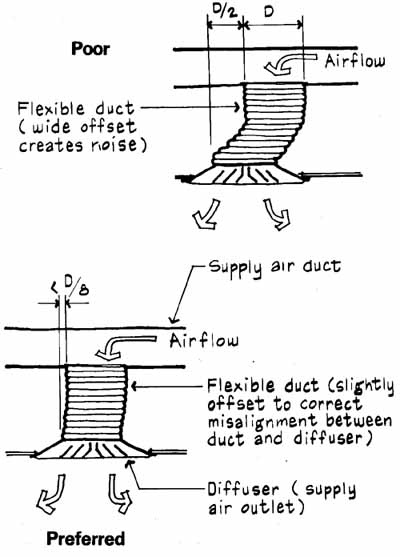AMAZON multi-meters discounts AMAZON oscilloscope discounts
The table below lists supply and return air velocities in feet per minute (fpm) for airflow through unobstructed, or “free,” openings and corresponding noise criteria. In auditoriums, theaters, and other critical listening spaces, the air velocities should be low so that the signal-to-noise ratios will be high. The values in the table apply to air ducts with internal glass- fiber linings and to registers and grilles with at least 1/2-in-wide slot openings. The values in the table should be used as rough guidelines for design purposes only when specific data on registers and grilles are unavailable for the air distribution layout, airflow volumes, and pressure drop conditions being evaluated.
Noise Criteria |
Air Velocity at Supply Register (fpm) |
Air Velocity at Return Grille (fpm) |
NC- 15 to NC-20 NC-20 to NC-25 NC-25 to NC-30 NC-30 to NC-35 NC-35 to NC-40 NC-40 to NC-45 |
250 to 300 300 to 350 350 to 425 425 to 500 500 to 575 575 to 650 |
300 to 360 360 to 420 420 to 510 510 to 600 600 to 690 690 to 780 |
Shown below are examples of poor and preferred air outlet conditions for “hard” and flexible ducts.
Removing the dampers and grille from the hard branch duct, as shown below in the preferred example, can reduce airflow noise from turbulence by more than 10 dB at mid-frequencies and also can increase the attenuation of low-frequency sound energy due to duct end reflection. When a small duct opens into the large volume of a room, low-frequency duct-borne sound energy is reflected back into the “end” of the duct (called end reflection). To achieve significant attenuation of low-frequency duct-borne sound energy (< 250 Hz) by end reflection: (1) use straight, small branch ducts greater than 3 times duct diameter D long; (2) suspend “deflector” (or plaque) at least 1 duct diameter beneath duct; and (3) don't use dampers, diffusers, or grilles.

Poor; Preferred
Note: Air velocities for the initial 10 ft of duct extending from supply registers or return grilles should not exceed the values given in the table by more than 20 percent.
Reference:
D. L. Klepper, W. J. Cavanaugh, and L. G. Marshall, “Noise Control in Music Teaching Facilities,” Noise Control Engineering Journal, September-October 1980, p. 75.
Next: Water-Piping System Noise Control
Prev: Lined Plenums
